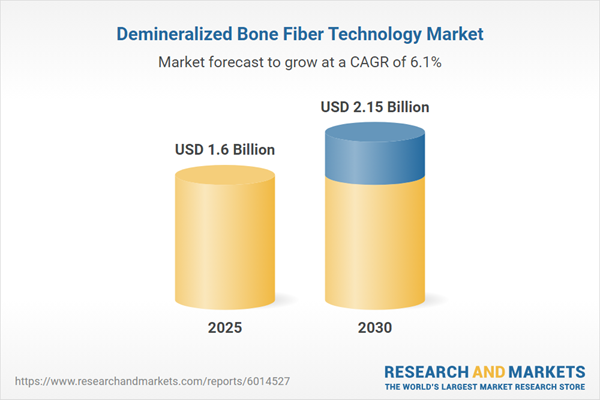Speak directly to the analyst to clarify any post sales queries you may have.
Demineralized bone fiber technology is advancing the field of regenerative medicine by delivering tailored solutions for complex tissue healing and repair. Senior decision-makers in healthcare, medtech, and supply chains are watching the sector as evolving clinical requirements and regulatory shifts create new opportunities for growth.
Market Snapshot: Demineralized Bone Fiber Technology Market
The Demineralized Bone Fiber Technology Market expanded from USD 1.51 billion in 2024 to USD 1.60 billion in 2025 and is projected to grow at a CAGR of 6.23%, reaching USD 2.45 billion by 2032. This upward trend reflects steady investment in material science innovation, a rising incidence of musculoskeletal conditions, and growing adoption of minimally invasive regenerative procedures. Industry stakeholders are focused on meeting rising patient demand, adapting to supply chain uncertainties, and responding to regional variations in healthcare standards and policy. Strong competition is prompting companies to differentiate through clinical outcomes, supply chain resilience, and technology leadership.
Scope & Segmentation
This report offers a comprehensive evaluation of the demineralized bone fiber technology ecosystem, highlighting the key drivers, emerging trends, and segmentation patterns that define competitive dynamics.
- Product Types: Includes fiber-based grafts that deliver enhanced handling, granule and powdered formulations offering adaptable clinical options, and advanced demineralized bone products designed for specific surgical applications.
- Applications: Spans craniofacial and maxillofacial reconstruction, cranial and skull repair, dental procedures (such as alveolar ridge augmentation, periodontal defect management, and preservation of extraction sites), orthopedic trauma care, fracture and nonunion management, and spinal fusion encompassing both lumbar and cervical approaches.
- End Users: Encompasses ambulatory surgical centers seeking efficiency, specialized dental clinics targeting precision procedures, hospitals with high throughput for complex cases, and research institutes driving forward biomaterial innovation.
- Regions: Analyzes the Americas, Europe, Middle East, Africa, and Asia-Pacific, with attention to influential countries like China, India, Japan, and Australia, emphasizing their distinct regulatory and clinical landscapes.
- Technologies: Examines demineralization processes optimized for cellular compatibility, fiber extraction for scaffold customization, surface modification, bioactive molecule integration to extend function, digital workflows, additive manufacturing for precision, and robust sterilization validation protocols.
- Major Companies: Assesses key industry participants including LifeNet Health, RTI Surgical Holdings, Musculoskeletal Transplant Foundation, AlloSource, Zimmer Biomet, DePuy Synthes, Stryker, Medtronic, Orthofix Medical, and NuVasive as drivers of market capability and innovation.
Key Takeaways for Senior Decision-Makers
- Fiber-based grafts support the management of complex anatomical defects and accelerate osseointegration by offering a porous scaffold for tissue in-growth.
- Recent advancements in manufacturing enable consistent biomaterial properties, supporting customized solutions across a range of clinical needs without sacrificing reproducibility.
- The shift toward outpatient and minimally invasive procedures is fueling a requirement for grafts characterized by improved handling, simplified delivery, and predictable surgical outcomes.
- Strategic collaborations among device manufacturers, research bodies, and clinical organizations are shortening time-to-market and enhancing clinical validation for new products.
- Variations in healthcare infrastructure and evolving regulatory climates are promoting regional product customization and fostering partnerships aimed at efficient local market entry.
- Organizations emphasizing digital integration, product differentiation, and continuous compliance are demonstrating higher operational adaptability in a fluctuating environment.
Tariff Impact on Supply Chains and Market Dynamics
Recent changes to United States tariffs in 2025 have influenced sourcing approaches for raw allograft materials, causing suppliers to increasingly favor domestic and nearshore partnerships. This shift is also driving more rigorous supplier assessments and encouraging conversations about vertical integration to achieve greater supply continuity. Higher import costs are stimulating interest in synthetic collagen analogs and encouraging raw material diversification, although these adaptations have resulted in new challenges for regulatory review and quality assurance.
Industry consolidation is emerging as a response to price and trade policy volatility, giving market leaders improved leverage for negotiations. Companies investing in optimized logistics, broader supplier portfolios, and robust partnerships are building resilience and maintaining margin stability throughout the segment.
Methodology & Data Sources
This study draws on extensive primary and secondary research. The evidence base included peer-reviewed journals, clinical registries, regulatory submissions, and patent records, supplemented with interviews from biomaterials experts, clinical practitioners, and regulatory professionals. Findings were validated through expert discussions and data triangulation.
Why This Report Matters
- Delivers strategic insights to guide investment in product development, supply network optimization, and geographic expansion within the demineralized bone fiber technology sector.
- Offers timely guidance on shifting market trends, evolving regulatory frameworks, and key segment drivers that impact technology adoption and market access.
- Enables robust benchmarking of major industry participants and reveals practical collaboration opportunities to support accelerated growth and commercialization strategies.
Conclusion
This report offers actionable intelligence for senior decision-makers, distilling the major operational challenges, market enablers, and strategic levers vital for ongoing progress in demineralized bone fiber technology.
Additional Product Information:
- Purchase of this report includes 1 year online access with quarterly updates.
- This report can be updated on request. Please contact our Customer Experience team using the Ask a Question widget on our website.
Table of Contents
3. Executive Summary
4. Market Overview
7. Cumulative Impact of Artificial Intelligence 2025
Samples

LOADING...
Companies Mentioned
The key companies profiled in this Demineralized Bone Fiber Technology market report include:- LifeNet Health, Inc.
- RTI Surgical Holdings, Inc.
- Musculoskeletal Transplant Foundation
- AlloSource
- Zimmer Biomet Holdings, Inc.
- DePuy Synthes, Inc.
- Stryker Corporation
- Medtronic plc
- Orthofix Medical Inc.
- NuVasive, Inc.
Table Information
| Report Attribute | Details |
|---|---|
| No. of Pages | 184 |
| Published | October 2025 |
| Forecast Period | 2025 - 2032 |
| Estimated Market Value ( USD | $ 1.6 Billion |
| Forecasted Market Value ( USD | $ 2.45 Billion |
| Compound Annual Growth Rate | 6.2% |
| Regions Covered | Global |
| No. of Companies Mentioned | 11 |









